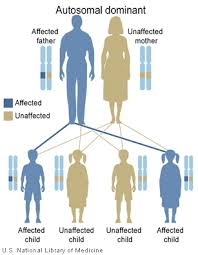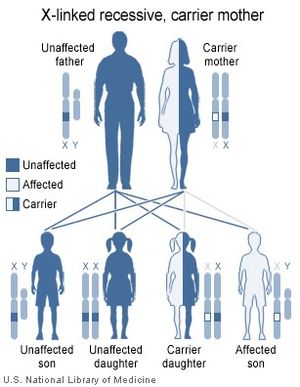Genetic Conditions and Inheritance: Difference between revisions
No edit summary |
No edit summary |
||
| Line 41: | Line 41: | ||
=== Genetic inheritance pathways === | === Genetic inheritance pathways === | ||
Genetic abnormalities can be inherited through different pathways, depending on the location and type of the affected gene. The three types of inheritance for monogenic (single-gene) diseases are<ref name=":1" />: | Genetic abnormalities can be inherited through different pathways, depending on the location and type of the affected gene. The three types of inheritance for monogenic (single-gene) diseases are<ref name=":1" />: | ||
*Dominant [see Image 1] | *Dominant [see Image 1] | ||
When inheriting a dominant allele from one parent, this trait is the one displayed in the phenotype. A dominant allele always prevails when combined with a recessive allele. | When inheriting a dominant allele from one parent, this trait is the one displayed in the phenotype. A dominant allele always prevails when combined with a recessive allele. | ||
[[File:Autosomal Recessive Inheritance-new.jpg|thumb|Image 2: Autosomal recessive inheritance of an affected gene (example of cystic fibrosis)<ref>Taken from: Wikimedia commons. File:X dominant affected mother.svg. Available from: https://commons.wikimedia.org/wiki/File:X_dominant_affected_mother.svg (accessed 5 November 2020).</ref>]] | |||
[[File:Autosomal Dominant Inheritance.jpg|thumb|Image 1: Autosomal dominant inheritance of an affected gene from the father <ref>Taken from: Wikimedia commons. File:X dominant affected mother.svg. Available from: https://commons.wikimedia.org/wiki/File:X_dominant_affected_mother.svg (accessed 5 November 2020).</ref>|center]] | |||
*Recessive [see Image 2] | *Recessive [see Image 2] | ||
When inheriting a recessive allele the trait is displayed in the phenotype not if it is combined with a dominant allele. The recessive trait is only activated if both alleles are recessive and no dominant allele of this gene is present. | When inheriting a recessive allele the trait is displayed in the phenotype not if it is combined with a dominant allele. The recessive trait is only activated if both alleles are recessive and no dominant allele of this gene is present. | ||
*X-linked | *X-linked | ||
[[File: | The inheritance of an X-linked allele can be both dominant [see Image 3] and recessive [see Image 4]. | ||
[[File:XlinkRecessive.jpg|thumb|Image 4: X-linked recessive inheritance of an affected gene from the mother<ref>Taken from: Wikimedia commons. File:X dominant affected mother.svg. Available from: https://commons.wikimedia.org/wiki/File:X_dominant_affected_mother.svg (accessed 5 November 2020).</ref>]][[File:X dominant affected mother.svg.jpg|thumb|Image 3: X-linked dominant allele, inheritance of an affected gene of the mother<ref>Taken from: Wikimedia commons. File:X dominant affected mother.svg. Available from: https://commons.wikimedia.org/wiki/File:X_dominant_affected_mother.svg (accessed 5 November 2020).</ref>|center]] | |||
[[File: | |||
==== The Punnet Square ==== | ==== The Punnet Square ==== | ||
The Punnet Square can be used to determine the possible outcomes of traits being transferred from the parents to the offspring. An example can be found in Image 2 on the right side, which shows the probability of inheriting cystic fibrosis from two parents both carrying a recessive allele for the disease. | The Punnet Square can be used to determine the possible outcomes of traits being transferred from the parents to the offspring. An example can be found in Image 2 on the right side, which shows the probability of inheriting cystic fibrosis from two parents both carrying a recessive allele for the disease. | ||
Revision as of 12:29, 5 November 2020
Introduction[edit | edit source]
Genetic conditions are diseases or disabilities that are caused by inherited or aquired abnormalities in the sequencing of the genome. They can be caused by mutations of the desoxyribonucleic acid (DNA) of single or multiple genes up to full chromosomal changes.[1] Genetic conditions that are caused by the modification of one single gene are called monogenic diseases.[2] The WHO estimates that there are around 10,000 human monogenic diseases which affect millions of people worldwide.
Heredity or genetic inheritance is the process of passing off trades or characteristics from parents to their offspring, also referred to as the study of genetics.[3] Traits get inherited through genes. These are sections of the DNA molecule which hold all information needed to for an organism to build new cells.
History[edit | edit source]
Gregor Mendel (1822-1884) was a scientist and monk from the Austrian Empire (today's Czech Republic) and is referred to as "the founder of the science of modern genetics".[4] His scientific experiments, which he conducted during his life in the monastery using pea plants, led him to construct the theory of inheritance of trades. Mendel was the first person to identify and prove the correct hypothesis of genetic inheritance of characteristics through "recessive" and "dominant" trades, which are both terms that he coined. He published his findings in 1865 but only gained posthumous recognition for the relevance of his work.
Genetic inheritance / Heredity[edit | edit source]
This chapter will capture the basics about inheritance. For a great visualisation about this topic see the YouTube video by the Crash Course brothers below.
Definitions[edit | edit source]
Traits[edit | edit source]
Traits - or characteristics - are observable details of an organism, e.g. in humans: one's eye colour, the shape of one's finger nails, ...
- Mendelian trait: A characteristic or trait that is determined by one gene only.[5] This means that a specific characteristic's information is found on only one of the 23 chromosome pairs that a human DNA. Therefore, the information about this particular characteristic is linked to one specific location within the DNA. The typical example is the colour of pea plant flowers, which was the trait that Mendel examined in his experiments.
- Poligenic trait: A characteristic or trait that is a composition of information from different genes, ergo not tied to one single location within the DNA. Most traits, since they are quite elaborate, are poligenic traits.
- Pleiotropic: A gene that influences how other genes are interpreted.
To best comprehend the pathway of genetic inheritance most commonly examples of Mendelian traits are used, since the observed trait is determined by one single gene.
Chromosomes[edit | edit source]
Chromosomes are the strings made of the DNA. In the human body they come in pairs. Humans have 23 pairs of chromosomes, each pair containing one set of genetic information from the mother and one from the father. Every cell in the human body holds 23 chromosome pairs, except for reproductive cells which only contain 23 single chromosome strings.[5]
Genes[edit | edit source]
Genes are the "basic physical unit of inheritance"[6] and are made of sequences within the DNA. They hold information about any type of process needed to grow, maintain and renew an organism's traits. The 23 chromosome pairs of humans hold around 20,000 genes.
Alleles[edit | edit source]
Humans have two sets of each genes, one in each of the chromosomes.[2] A pair of genes is called an allele. These genes do not necessarily need to be the same since one of them is inherited from the mother and the other one from the father.
Genotype[edit | edit source]
The genotype is the composition of the two parentally inherited alleles. [3]
- Heterozygous: Genotype has two alleles that are different.
- Homozygous: Genotype has two alleles that are alike.
Phenotype[edit | edit source]
The phenotype is defined as "the set of characteristics of a living thing, resulting from its combination of genes and the effect of its environment"[7] hence the 'final result' of the composition of parentally inherited and environmentally acquired information.
Genetic inheritance pathways[edit | edit source]
Genetic abnormalities can be inherited through different pathways, depending on the location and type of the affected gene. The three types of inheritance for monogenic (single-gene) diseases are[2]:
- Dominant [see Image 1]
When inheriting a dominant allele from one parent, this trait is the one displayed in the phenotype. A dominant allele always prevails when combined with a recessive allele.


- Recessive [see Image 2]
When inheriting a recessive allele the trait is displayed in the phenotype not if it is combined with a dominant allele. The recessive trait is only activated if both alleles are recessive and no dominant allele of this gene is present.
- X-linked
The inheritance of an X-linked allele can be both dominant [see Image 3] and recessive [see Image 4].


The Punnet Square[edit | edit source]
The Punnet Square can be used to determine the possible outcomes of traits being transferred from the parents to the offspring. An example can be found in Image 2 on the right side, which shows the probability of inheriting cystic fibrosis from two parents both carrying a recessive allele for the disease.
Diagnosis[edit | edit source]
Newborn genetic screening is a standard procedure for most babies which is conducted right after birth in many countries.[12] It helps to identify genetic disorders at an early stage so that prevention and treatment methods can set in from the very beginning.
Clinical relevance[edit | edit source]
Most common disorders[edit | edit source]
Monogenic diseases:
- Haemophilia
- Von Willebrand Disease (specific form of haemophilia)
- Thalassaemia
- Sickle Cell Anaemia
- Cystic fibrosis
- Tay Sachs disease
- Huntington's disease
Poligenic diseases:
Others:
- Down Syndrome/ Trisomy 21 (caused by an extra chromosome on the 21st chromosome pair)
- Edward's Syndrome/ Trisomy 18 (caused by an extra chromosome on the 18th chromosome pair)
Disorders relevant for physiotherapy practice[edit | edit source]
Treatment[edit | edit source]
Experimental genometherapy[edit | edit source]
Physiotherapy[edit | edit source]
References[edit | edit source]
- ↑ Genetic Disorders. University of Utah Genetic Science Learning Centre. Available from: https://learn.genetics.utah.edu/content/disorders/ (accessed 5 November 2020).
- ↑ 2.0 2.1 2.2 Genes and human diseases. WHO. Available from: https://www.who.int/genomics/public/geneticdiseases/en/index2.html (accessed 5 November 2020).
- ↑ 3.0 3.1 Genetic inheritance. Basic Biology 2020. Available from: https://basicbiology.net/micro/genetics/genetic-inheritance (accessed 3 November 2020).
- ↑ Gregor Mendel. Wikipedia. Available from: https://en.wikipedia.org/wiki/Gregor_Mendel (accessed 3 November 2020).
- ↑ 5.0 5.1 Heredity: Crash Course Biology #9. Crash Course (YouTube Channel). Available from: https://www.youtube.com/watch?v=CBezq1fFUEA (accessed 3 November 2020).
- ↑ Gene. National Human Genome Research Institute. Available from: https://www.genome.gov/genetics-glossary/Gene (accessed 5 November 2020).
- ↑ Phenotype. Oxford Learner's Dictionaries. Available from: https://www.oxfordlearnersdictionaries.com/definition/english/phenotype?q=phenotype (accessed 3 November 2020).
- ↑ Taken from: Wikimedia commons. File:X dominant affected mother.svg. Available from: https://commons.wikimedia.org/wiki/File:X_dominant_affected_mother.svg (accessed 5 November 2020).
- ↑ Taken from: Wikimedia commons. File:X dominant affected mother.svg. Available from: https://commons.wikimedia.org/wiki/File:X_dominant_affected_mother.svg (accessed 5 November 2020).
- ↑ Taken from: Wikimedia commons. File:X dominant affected mother.svg. Available from: https://commons.wikimedia.org/wiki/File:X_dominant_affected_mother.svg (accessed 5 November 2020).
- ↑ Taken from: Wikimedia commons. File:X dominant affected mother.svg. Available from: https://commons.wikimedia.org/wiki/File:X_dominant_affected_mother.svg (accessed 5 November 2020).
- ↑ What is Newborn Genetic Screening? Genetics Science Learning Centre University of Utah. Available from: https://learn.genetics.utah.edu/content/disorders/screening/ (accessed 5 November 2020).






